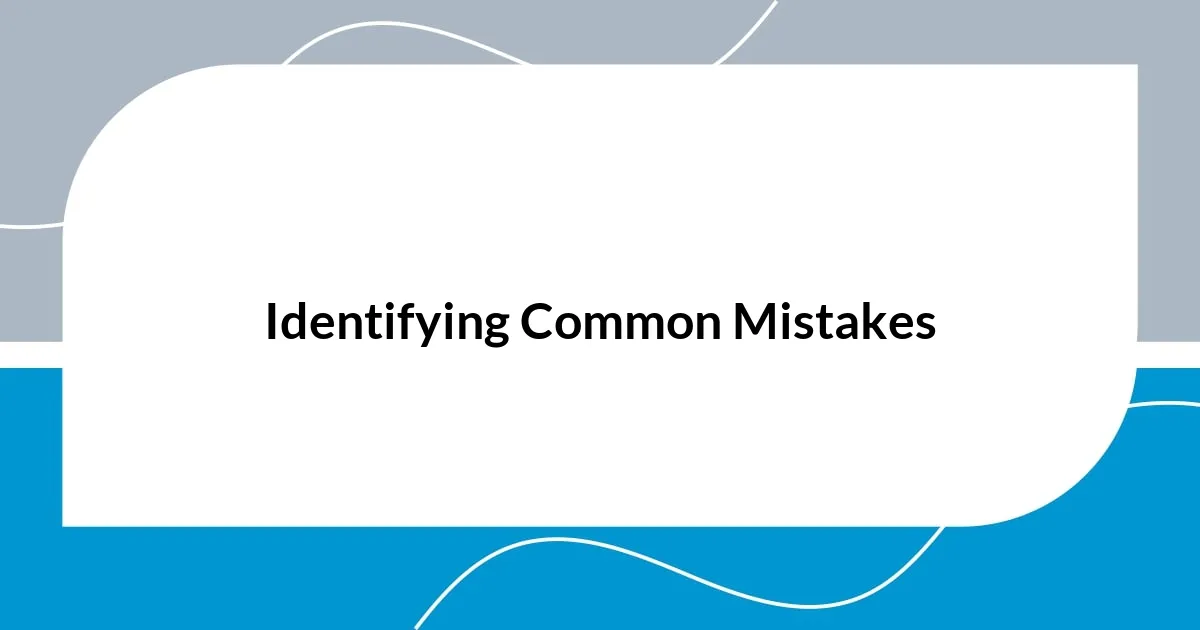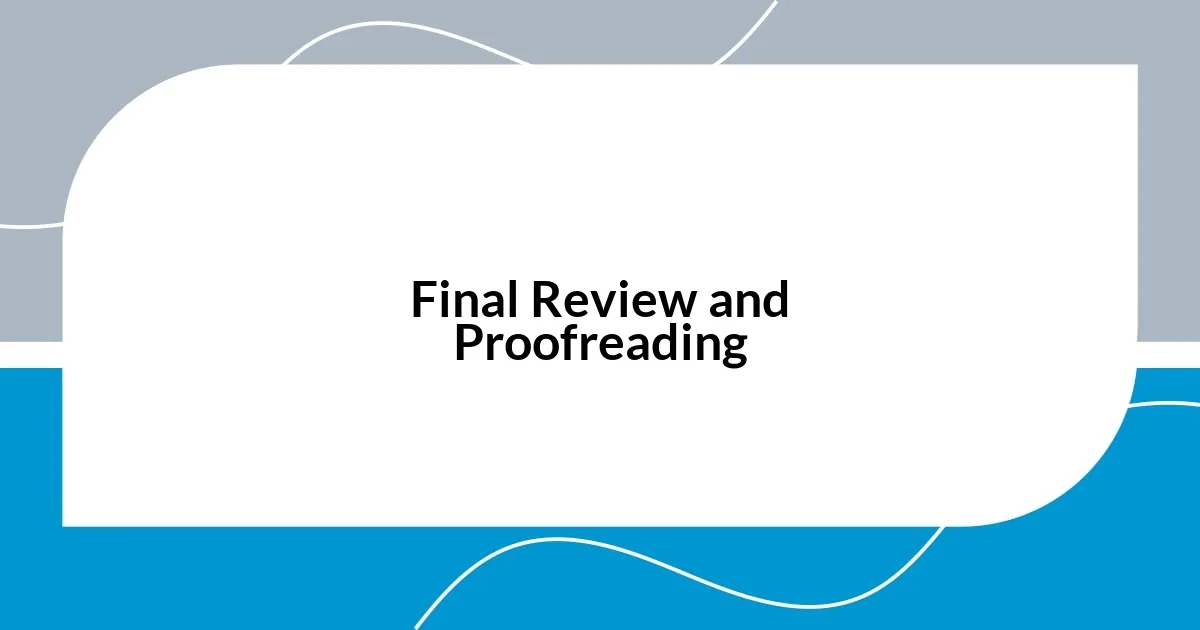Key takeaways:
- Self-editing is both an art and a necessity, requiring a balance between critical evaluation and empathy for the audience.
- Techniques like reading aloud and taking breaks enhance clarity and help identify awkward phrases or inconsistencies.
- Creating an editing checklist targets common mistakes and ensures a polished final product, focusing on clarity, tone, and punctuation.
- Final review strategies, such as changing formats and reading backward, reveal overlooked errors and improve overall writing quality.

Understanding Self-Editing
When I first delved into self-editing, I discovered it’s not just a technical process; it’s an art. Have you ever poured your heart into writing, only to find that some parts simply don’t resonate? I remember going through my drafts, feeling almost hurt by the realization that some lines I cherished didn’t enhance my message.
I often think of self-editing as a conversation with my inner critic. It’s crucial to embrace that voice, but I also learned to temper it with kindness. Instead of feeling defeated when I had to cut a paragraph I loved, I would ask myself, “Is it serving the story?” This mindset shift transformed my editing sessions from painful chores into enlightening discoveries.
Finding clarity in my writing has always been a challenge. I’ve found that stepping away from my work for a while allows me to return with fresh eyes. Has this ever happened to you? It’s amazing how taking a breather can reveal awkward phrases or inconsistencies that I had overlooked in the heat of creation.

Importance of Self-Editing
Self-editing is the backbone of effective writing. It allows me to refine my thoughts and ensure that the essence of my message shines through. I recall a time when I submitted a piece only to realize later that my main argument was buried in a sea of unnecessary details. That moment taught me the power of cutting through the clutter to highlight what truly matters.
Moreover, I find self-editing to be an exercise in empathy—not just for my audience, but for myself as a writer. During one editing session, I stumbled upon a paragraph I thought was brilliant, but it felt disconnected from the rest of my work. It was a tough decision, but I chose to let it go. This experience reinforced the importance of putting the reader’s experience first, ensuring my writing remains engaging and clear.
The emotional journey of self-editing can be enlightening. Each draft holds a piece of my personality, and while it can be heartbreaking to cut sections that I felt proud of, I’ve learned that every edit gets me closer to my true voice. After all, editing isn’t just about what to remove; it’s also about enhancing what I’ve already created and making it resonate with those who will read it.
| Aspect | Importance of Self-Editing |
|---|---|
| Clarity | Refines thoughts and enhances message delivery |
| Empathy for Audience | Takes reader experience into account |
| Growth | Facilitates personal and creative development |

Initial Read-Through Techniques
When I sit down for my initial read-through, I like to treat it as a personal journey, stepping into the shoes of my future readers. I often encourage myself to read the piece out loud. There’s something about hearing the words spoken that can unveil clumsy phrases or uneven pacing that might slip by when I’m merely reading silently. In one instance, I found a paragraph that sounded elegant in my head but fell flat when voiced. This simple act of reading aloud transformed my understanding of how the piece flowed and connected.
As I embark on my initial read-through, these techniques come in handy:
– Read Aloud: Hearing your work helps catch awkward rhythms and unclear phrases.
– Change the Format: Sometimes, I switch to a different format, like printing out the text, to see it from a new perspective.
– Take Breaks: Giving myself a moment to breathe away from the text and then returning to it fresh often reveals overlooked errors or areas needing improvement.
– Annotate as You Go: Jotting down thoughts or questions enhances my understanding of what resonates and what doesn’t.
– Focus on Sections: Instead of trying to edit the entire piece in one go, I hone in on smaller sections to ensure clarity and coherence.
Engaging in these techniques makes this initial read-through an exciting part of my editing process, rather than a daunting task. Each time I employ these strategies, I feel as though I’m peeling back layers to discover the heart of my writing. It’s truly rewarding!

Identifying Common Mistakes
Identifying common mistakes in my writing is a crucial part of my editing process. One area I often struggle with is redundancy. I vividly remember a piece where I repeatedly used phrases to emphasize my point, only to find that they muddied my message. I learned that less is often more; streamlining my writing not only enhances clarity but also keeps the reader engaged. Have you ever noticed how sometimes you can say something perfectly once, only to trip over it by saying it again?
Typos and grammatical errors can sneak into my work, despite my best efforts. Once, I submitted an article that contained a few glaring mistakes, and I felt utterly embarrassed when the editor pointed them out. I learned then that having a checklist of common errors I tend to make—like mixing up “their” and “there”—can be a game-changer in catching these blunders before anyone else does. It’s almost like creating my own guide to navigate the pitfalls of my writing.
Another mistake I often face is inconsistency in tone. Early in my writing journey, I penned a blog post that started as an informative piece but veered into an overly casual tone as it progressed. This shift left my readers confused about what to expect from my content. I realized it’s essential to outline not just my ideas, but also the emotions and voice I want to convey throughout. Have you ever found yourself bouncing back and forth between formal and casual language? Establishing a clear tone from the start helps maintain a logical flow and keeps my audience fully engaged.

Developing an Editing Checklist
Developing an editing checklist has become one of my go-to strategies for ensuring a polished piece. I start by identifying the specific areas I often overlook. For example, I used to neglect punctuation, but after a few embarrassing mishaps—like sending out a newsletter with misplaced commas—I decided to create a dedicated section in my checklist just for grammar and punctuation. Now, each time I edit, I systematically check this list, and I can feel the difference in the quality of my writing.
Another key component of my checklist focuses on content clarity. Recently, I submitted an article that I thought was crystal clear, only to receive feedback stating it was confusing in parts. This prompted me to add a “clarity check” to my checklist. When I see a complex sentence, I now pause to ask myself: Does this idea come through simply? I’ve found that breaking these sentences down makes the writing more engaging for readers—something I truly value.
Lastly, I always include a section on tone and audience in my checklist. I remember crafting a thoughtful piece about mental health, only to realize halfway through that my language felt too clinical. It left me wondering: How would my audience resonate with this clinical approach? Now, I ask myself, “Is my tone inviting and appropriate for my audience?” This question ensures that my writing feels connected and authentic, leading to better engagement with my readers.

Revising for Clarity and Flow
Revising for clarity and flow has become a key part of my writing process. I remember a time when I submitted a blog about productivity, proud of my ideas but oblivious to how jumbled my paragraphs had become. I quickly learned the importance of reading my work aloud. It’s astonishing how hearing your words can reveal awkward phrasing or convoluted sentences that might trip up even the most eager reader. Have you ever had a moment where listening to your own writing opened your eyes to its flaws?
When focusing on flow, I often reevaluate the order of my ideas. In one of my earlier pieces about self-care practices, I started with the benefits before diving into specific activities. The transition felt abrupt. I decided to outline my content more thoughtfully—starting with relatable challenges before offering solutions. When I structure my thoughts logically, it creates a natural progression, allowing the reader to journey with me rather than feel lost in a maze of information. Do you find it easier to relate to a story when it unfolds in a logical sequence?
Another strategy that has improved my clarity is breaking down complex ideas into digestible chunks. I remember one article where I tried to tackle multiple concepts in one paragraph. It felt insightful at first, but feedback revealed it was overwhelming for readers. Now, I challenge myself to limit each paragraph to a single idea, often asking, “How can I simplify this for my audience?” This not only serves the writing but also respects the reader’s time and attention, making my points more impactful. Have you noticed how a little simplification can, in fact, lead to a stronger message?

Final Review and Proofreading
Finalizing a piece of writing can be a daunting task, but I find that my approach to the final review and proofreading can truly elevate its quality. I remember one specific instance where I thought my article was ready to go, but I decided to step away for a day. When I returned, I discovered several typos and phrases that just didn’t sound right. It’s incredible how taking a little break can provide a fresh perspective. Have you ever noticed how a little distance can reveal things you overlooked?
I’ve also made it a habit to use a different medium for my final review. For instance, I often switch from a computer screen to a printed version. This simple change can highlight errors and awkward wording that I might have missed during my usual editing process. I recall one time when a misplaced word changed the entire meaning of a sentence, something I only caught when reading from paper. It’s fascinating how such a small adjustment can significantly affect your focus.
During my proofreading, I prioritize reading backward—starting from the end and working towards the beginning. This technique forces me to detach from the overall narrative and spot grammatical errors without getting distracted by the content itself. It may sound a bit unconventional, but it works wonders! Have you tried this method? It might seem tedious, but I’ve found that treating each sentence as its own entity ensures nothing slips through the cracks in the final review.